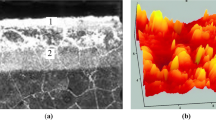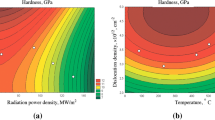Abstract
Laser surface tempering causes reduction in the surface hardness without affecting the bulk material hardness. The tempering behavior can be advantageous in advanced manufacturing processes that require controlled softening of the surface layers of through-hardened high-strength steels. This paper presents a computational phase change kinetics-based model for selecting the laser parameters that temper the surface layers of a through-hardened hyper-eutectoid steel (AISI 52100) over a known depth. First, a three-dimensional analytical thermal model is used to evaluate the temperature field produced in the material due to thermal cycles produced by laser scanning of the surface. The computed temperature histories are then fed to the phase-change model to predict the surface and subsurface hardness for the chosen laser-processing conditions. Microstructural analysis of the laser-treated AISI 52100 workpiece surface is presented for different laser-processing conditions. It is shown that good agreement is achieved between the predicted and measured surface hardness.















Similar content being viewed by others
Abbreviations
- t :
-
Time (seconds)
- T(t):
-
Temperature (K)
- \( X,Y, Z \) :
-
Coordinate representation
- A 1 :
-
Eutectoid temperature of the steel (K)
- A CM :
-
A CM temperature of steel (K)
- C C :
-
Critical carbon concentration, 0.05 pct
- C o :
-
Carbon concentration in ferrite before laser hardening (wt pct)
- \( C_{\gamma }^{\text{c}} \) :
-
Carbon content in austenite in equilibrium with cementite (wt pct)
- \( C_{\text{c}}^{\gamma } \) :
-
Carbon content in cementite in equilibrium with austenite (wt pct)
- C m :
-
Mean carbon content in martensite (wt pct)
- C p(T):
-
Specific heat (J m−1 K−1)
- D :
-
Laser spot diameter (m)
- D o :
-
Pre-exponential for diffusion of carbon (m2 s−1)
- D t :
-
Frequency factor for tempering (s−1)
- f :
-
Volume fraction of carbon
- h :
-
Lumped convection coefficient (W m−2 K−1)
- H :
-
Hardness of the surface (HV)
- H o :
-
Hardness of as-quenched state (HV)
- H a :
-
Hardness of annealed state (HV)
- H v :
-
Hardness of tempered state (HV)
- I(t):
-
Kinetic strength of the heat cycle
- I t(t):
-
Activation energies for tempering
- k(T):
-
Thermal conductivity (J s−1 m−1 K−1)
- K :
-
Supersaturation parameter
- K c :
-
Critical carbon concentration factor
- m :
-
Aging exponent of the material
- M s :
-
Martensite start temperature (K)
- M e :
-
Martensite finish temperature (K)
- n :
-
Empirical exponent of the diffusion mechanism
- P o :
-
Output power of the laser source (W)
- P i :
-
Incident laser power (W)
- \( P_{{{\text{a}}(X,Y,Z)}} \) :
-
Power distribution at location X, Y, Z (W)
- ρ :
-
Density (Kg m−3)
- Q :
-
Activation energy for diffusion of carbon (J mol−1)
- \( \dot{Q}_{h} \) :
-
Rate of heat generation (W m−3)
- R :
-
Universal gas constant (8.314 J mol−1 K−1)
- R t :
-
Instantaneous radius of the particle (m)
- r i :
-
Average initial radius of cementite particle (m)
- 2r e :
-
Average spacing of adjacent cementite particles (m)
- τ v(t):
-
Tempering ratio
- T melt :
-
Melting point of the material (K)
- T n :
-
Nose temperature of the material, obtained from the material transformational diagrams (K)
- T o :
-
Ambient temperature (K)
- ΔT :
-
Undercooling temperature (K)
- V y :
-
Laser scan speed (m s−1)
- \( {\text{Fe}},\,{\text{C,}}\, {\text{As}},\,{\text{Cu}},\,{\text{Cr}},\,{\text{Mo}},\,{\text{Mn}},\, {\text{Ni}},\,{\text{P}},\,{\text{Si}},\,{\text{V}},\,{\text{W}} \) :
-
Alloying constituents of the steel (iron, carbon, arsenium, copper, chromium, molybdenum, manganese, nickel, phosphorus, silicon, vanadium, tungsten, respectively)
- \( f_{\text{m}} ,\,f_{\text{p}} ,\,f_{\text{ce}} ,\, f_{\text{ra}} ,\,f_{\text{f}} ,\,f_{ \in } \) :
-
Volume fraction of martensite, pearlite, cementite, retained austenite, ferrite, \( \in \)-carbide, respectively
- \( H_{\text{m}} ,\,H_{\text{ce}} ,\,H_{\text{f}} ,\,H_{ \in } \) :
-
Hardness (HV) of martensite, cementite, ferrite, \( \in \)-carbide, respectively
- Λ :
-
Wavelength of incident beam
- \( \in \) :
-
Emissivity of the material
- η :
-
Efficiency of laser source
- 2θ :
-
Diffraction angle (deg)
References
S. Lei and F.E. Pfefferkorn: Proc. ASME Int. Conf. Manufact. Sci. Eng., ASME, Atlanta, GA, 2007, pp. 1–12.
S. Sun, M. Brandt, and M.S. Dargusch: Int. J. Mach. Tool Manufact., 2010, vol. 50 (8), pp. 663–80.
W.M. Steen and C.H.G. Courtney: Met. Technol., 1979, pp. 456–66.
M.F. Ashby and K.E. Easterling: Acta. Metall. Mater., 1984, vol. 32, no. 11, pp. 1935-48.
R.K. Shiue and C. Chen: Metall. Trans. A, 1992, vol. 23A, no. 1, pp. 163-70.
S. Raghavan, S. Melkote, F. Hashimoto: Proc. NAMRI/SME, vol. 39, pp. 224-32, 2011.
F.E. Werner, B.L. Averbach, M. Cohen: Trans. ASM, 1957, vol. 49, pp. 823-41.
G.R. Speich and W.C. Leslie: Metall. Trans., 1972, vol. 3A, pp. 1043-54.
M.S. Devgun and P.A. Molian: J. Mater. Process Tech., 1990, vol. 23 (1), pp. 41–54.
R.S. Lakhar, Y.C. Shin, and M.J.M. Krane: Mater. Sci. Eng. A Struct., vol. 480 (1–2), pp. 209–17.
L. Giorleo, B. Previtali, and Q. Semeraro: Int. J. Adv. Manufact. Technol., 2011, vol. 54, pp. 969-77.
M.R. Frewin, and D.A. Scott: Weld. J., 1999, vol. 78, no. 1, pp. 15s-22s.
J. Alda: Encyclopedia of Optical Engineering, Marcel Dekker Inc., New York 2006.
W.B. Li, M.F. Ashby, and K.E. Easterling: Acta. Metall. Mater., 1986, vol. 34, no. 8, pp. 1533-48.
Z. Zhang, D. Delagnes, and G. Bernhart: Mater. Sci. Eng. A Struct., 2004, vol. 380 (1–2), pp. 222–30.
C. Fiorletta: Metals Handbook, 9th edition, vol. 4, pp. 518-21, ASM, Metals Park, OH, 1981.
C.S. Roberts: Trans. AIME, 1953, vol. 197, pp. 203-04.
A.R. Marder and G. Krauss: Trans. ASM, 1967, vol. 60, pp. 651-60.
M. Cohen: Trans. ASM, 1949, vol. 41, pp. 35-94.
B.S. Lement, B.L. Averbach, and M. Cohen: Trans. ASM, 1954, vol. 46, pp. 851-81.
A.T. Balliet and G. Krauss: Metall. Trans. A, 1976, vol. 7A, pp. 318-20.
W. Johnson and R. Mehl: Trans. AIME, 1939, vol. 135, pp. 416-42.
M. Avrami: J. Chem. Phys., 1939, vol. 7, pp. 1103-112.
R.F. Mehl, and W.C. Hagel: Progress in Metal Physics, vol. 6, pp. 74-134, Pergamon Press, New York, 1956.
A.T.G. Gustavo: M.S. Thesis, Georgia Institute of Technology, Atlanta, Georgia, 2002.
Y.B. Guo and C.R. Liu: J. Manufact. Sci. Eng. T ASME, 2002, vol. 124 (2), pp. 189–99.
B. Podgornik, M. Kalin, J. Vizintin, and F. Vodopivec: J. Tribol. T ASME, 2001, vol. 123 (4), pp. 670–75.
D. Umbrello, J. Hua, and R. Shivpuri: Mat. Sci. Eng. A Struct., 2004, vol. 374, pp. 90-100.
Y.S. Touloukian: “Thermophysical Properties of Matter,” Thermophysical Properties Research Center, Purdue University, West Lafayette, Indiana, 1970
E.C. Bain and H.W. Paxton: Alloying Elements in Steel, 2nd edition, ASM, Metals Park, OH, 1961.
K.W. Andrews: J. Iron and Steel Inst., 1965, vol. 203, pp. 721-27.
ASTM Standard E975-03: Standard Practice for X-ray Determination of Retained Austenite in Steel with Near Random Crystallographic Orientation, ASTM, West Conshohocken, PA 2008.
C.J. Smithells: Metals Reference Book, 4th edition, vol. 2, p. 649, Butterworths, London, 1967.
M. Hillert: Jernkot. Ann., 1957, vol. 141, pp. 557-85.
M. Hillert, K. Nilsson, and L.E. Törndahl: J. Iron Steel Inst., 1971, vol. 209 (1), pp. 49–66.
V.M. Li, D.V. Niebuhr, L.L. Meekisho, and D.G. Atteridge: Metall. Mater. Trans. B, 1997, vol. 28B, pp. 661-72.
G. F. Vander Voort: Atlas of Time-Temperature Diagrams for Irons and Steels, p. 127, ASM International, Materials Park, Ohio, 1991.
A. Jacot, M. Rappaz, and R.C. Reed: Acta. Metall. Mater., 1997, vol. 46, no. 11, pp. 3949-62.
J. Holloman and L. Jaffe: Trans. AIME, 1945, vol. 162, pp. 223-49.
H. Pantsar and V. Kujanpaa: J. Laser Appl., 2003, vol. 16 (3), pp. 147–53.
Acknowledgments
The first two authors are grateful to Dr. F. Hashimoto of The Timken Company, Canton, OH, USA for his encouragement and support of the work reported in this paper. The authors also acknowledge access to XRD facilities for phase analysis in the School of Materials Science & Engineering at Georgia Tech.
Author information
Authors and Affiliations
Corresponding author
Additional information
Manuscript submitted November 4, 2012.
Rights and permissions
About this article
Cite this article
Raghavan, S., Melkote, S.N. & Hong, JI. Modeling of Laser-Tempering Process for Hyper-Eutectoid Steels. Metall Mater Trans A 45, 2612–2625 (2014). https://doi.org/10.1007/s11661-014-2204-6
Published:
Issue Date:
DOI: https://doi.org/10.1007/s11661-014-2204-6




